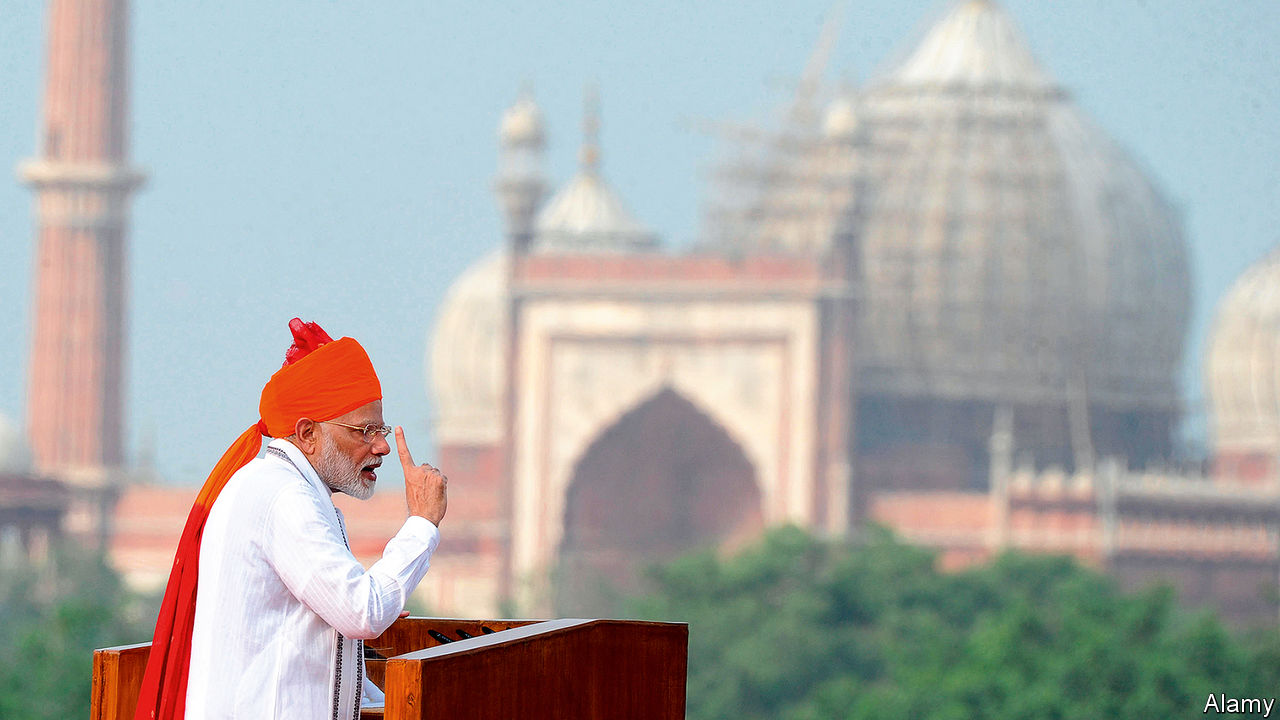
STOCK UP ON namkeens. The compellingly munchable snacks are what Indians will be craving in 2019, with their ringside seats for what promises to be one of the most nail-biting and most consequential elections in India’s 71 years of independence. The world’s biggest democracy heads to the polls some time in late spring, the pre-monsoon season when temperatures soar highest. It is not just the weather that will be hot.
The contest will in part be a referendum on Narendra Modi, the 68-year-old prime minister who in 2014 brought his Bharatiya Janata Party (BJP) India’s first single-party parliamentary majority in three decades. That landslide suggested broad endorsement for its pro-business and Hindu-nationalist agenda, as well as support for Mr Modi’s carefully tended mix of patriarchal mien, folksy talk and energetic boosterism. But after five years in office, the halo surrounding the former tea-boy from Gujarat has faded. Mr Modi’s political magic button, marked “resentment at ruling elites”, no longer produces Pavlovian roars of approval. With his perfectly pressed pastel-coloured kurtas and hugging matches with world leaders, Mr Modi himself now looks pretty elite.
His party and its platform, which seemed an unstoppable juggernaut until halfway through Mr Modi’s term, has also grown less fearsome. The BJP still has more money by far than any rival, thanks to wealthy and loyal patrons. This is a key asset in Indian elections, as are the party’s superior discipline, better tactical commanders and, crucially, its close ties with grassroots Hindu-nationalist groups that provide reliable shock troops across the country. Yet for all this strength, the party’s record in power has looked surprisingly weak by many measures. This has alienated important constituencies.
One of these is businesspeople, many of whom had seen Mr Modi’s powerful mandate as an opportunity to push through sweeping free-market reforms. Instead, misguided policies such as the overnight “demonetisation” of 86% of India’s currency in 2016, or inept ones such as the clumsy imposition of needlessly high and complex national sales taxes in 2018, or a failure to address a looming bad-debt crunch in state-owned banks, have tended to overshadow achievements including Mr Modi’s laudable fiscal probity and the passage of much-needed economic laws, for example on bankruptcy.
But when it comes to revising land and labour laws that constrain India’s economic growth, or privatising unaccountable and inefficient state assets, the BJP has proved disappointingly timid. As for economic growth, Mr Modi has produced solid results, but his immediate predecessor’s were better.
At the other end of India’s vast social scale, farmers, lower-caste Hindus and religious minorities all have reason to have fallen out of love with the BJP. Mr Modi’s tenure has seen an ugly surge in violence directed against India’s less privileged, often by groups or individuals associated with the Hindu-nationalist right. The poor have also been hit by rising global oil prices, a weaker Indian rupee and falling farmgate prices. Intellectuals, journalists, academics and other opinion-makers, meanwhile, have been put off by the Modi government’s dictatorial style: rather than upend the stuffy dominance of a long-entrenched establishment, as many had hoped, the BJP has simply inserted loyalists to run the same old system.
All this works to the advantage of Mr Modi’s foes, most notably Congress, the legacy party of India’s independence movement. And so too does a force often described as the most powerful in India’s fickle political game, anti-incumbency. If this were the potent Congress party of past decades, the BJP’s doom would probably have been sealed. But despite being the only real national-level rival to the BJP, and indeed the only other party with a presence in every Indian state, Congress is a shadow of its former self. Its leader, too, is no match for Mr Modi in political skill: Rahul Gandhi may be younger, and may also have grown into his job as “crown prince” of the Nehru-Gandhi dynasty that has commanded Congress for four generations, but he lacks the BJP leader’s street-fighting tenacity.
No one expects Congress to take on the BJP on its own, however, and Mr Gandhi has also been coy about whether he would actually seek to be prime minister. The likely strategy is for Congress to patch together a rainbow of anti-BJP forces, largely composed of the regional and identity-based parties whose growing importance has been a salient development in recent years. If Congress can hold together such a coalition—and that is a very big if—then Mr Modi’s days might be numbered.
But that is not what makes this election so momentous. Beyond the struggle between parties and personalities, Indians sense an underlying struggle over the country’s soul. If Mr Modi wins a second term, his party may be even blunter in imposing its Hindu-nationalist vision of a more muscular, less tolerant India. Should Congress and its multifarious allies capture power, their critics fear, India will return to its bumbling, corrupt old ways. The more likely result: whoever rules, India will remain too wildly diverse for any one trend to dominate.
This article appears in “The World in 2019”, our annual edition that looks at the year ahead. See more at worldin2019.economist.com








